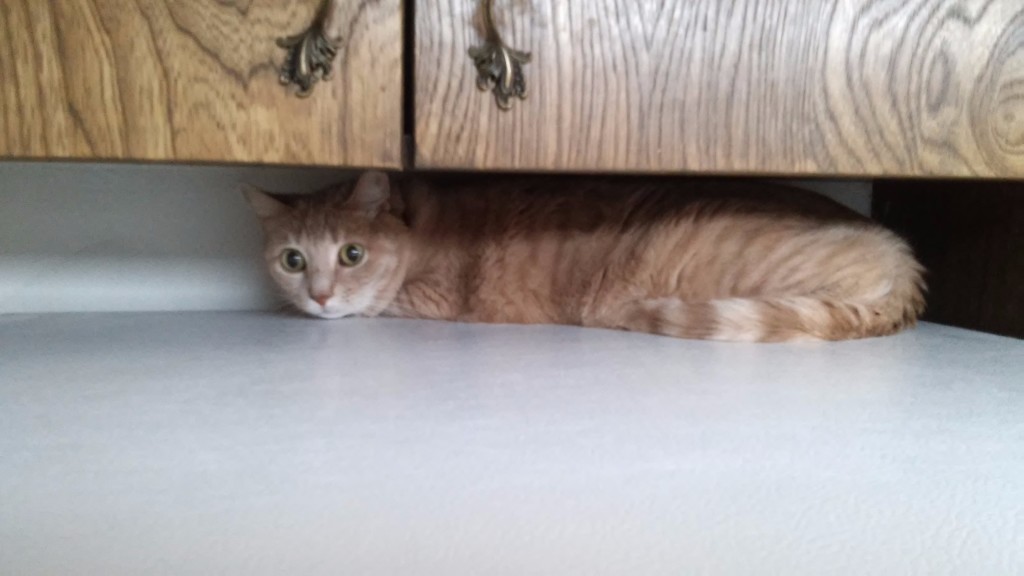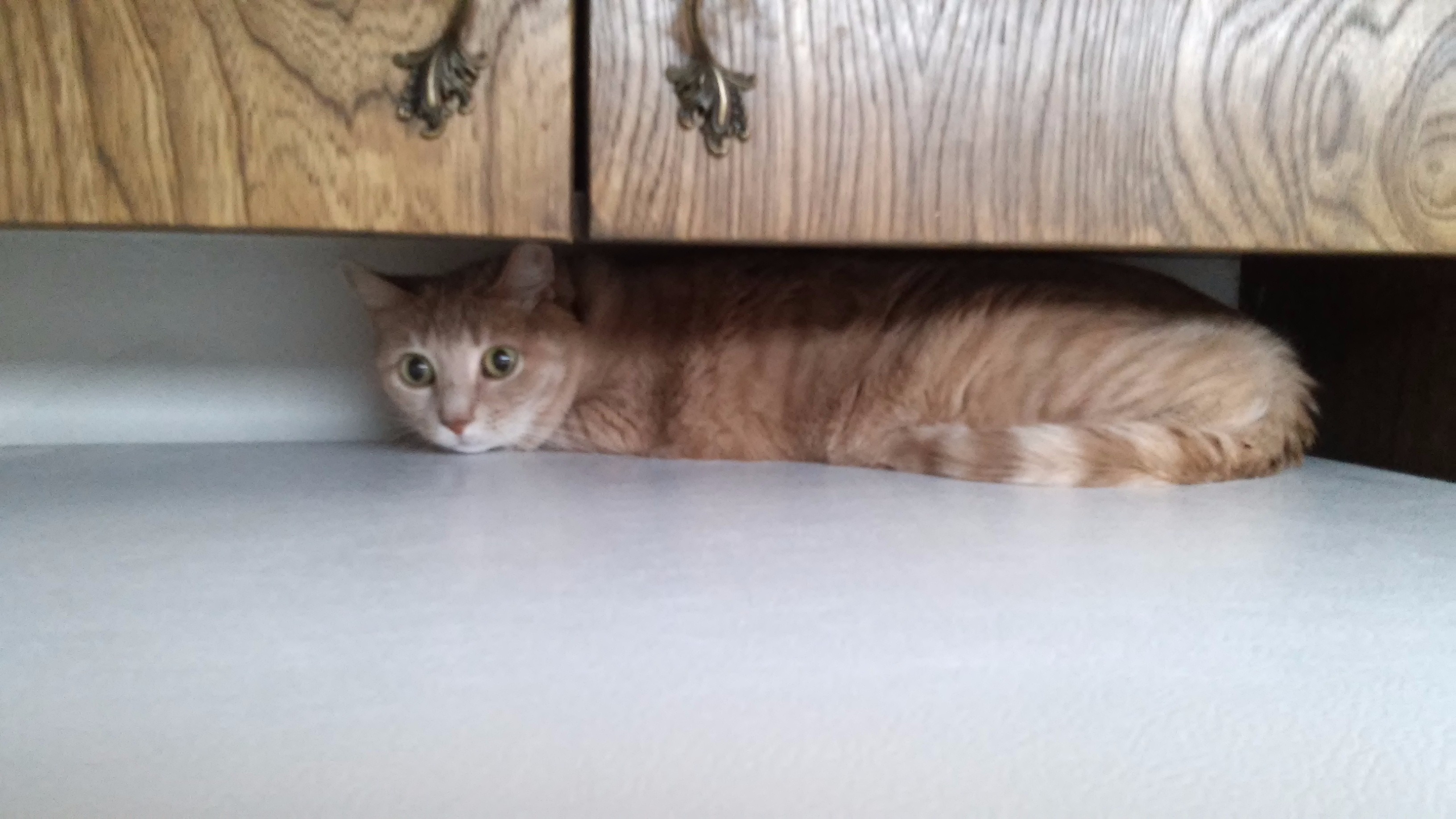Keith Boone, Pet Travel Agent
By Mariel Williams
Editor
I was fighting a cold, stiff wind in downtown Austin, looking for an unassuming office in an unadorned building.
My mission was threefold: One, to find out if “pet travel agent” is as interesting a job as it sounds. Two, to determine whether you, dear reader, could find such a job. Three, to find out why, after following her vet’s advice to the letter, my cat became so distressed at moving to Austin that she pulled out her front teeth.
My informant was Keith Boone, who had made an unlikely leap from life as an accountant to a career as a professional pet relocator.

The cat’s name is Eglantine, but she’s not really all that relevant.
If you are here, you probably waste a lot of time on the internet. If you waste a lot of time on the internet, you probably spend a lot of time daydreaming about a more interesting job. Somewhere else. Somewhere better. Like Orlando. Or France.
If you spend a lot of time daydreaming about being offered a job in France, you might occasionally wonder how you would move your dog there. A pet relocator is how.
“When people move internationally, for a job, usually… we are travel agents for their pets,” Boone told me. Keith worked for Pet Relocation, an Austin business dedicated to ensuring that animals move just as safely as their owners.
“We coordinate people around the world to actually go to your door and pick up your dog,” Boone said. “Everything is door-to-door.” When I talked to Boone, I had two main questions in mind. One, how exactly did he luck into such a unique career? Two, when I moved my cat from North Carolina to Texas and she pulled out her teeth, what exactly did I do wrong? The answer to both questions turned out to be fairly simple.
Most of the work of professional pet relocation is done by outside contractors—major airlines, ground transport companies, veterinarians, etc. What a relocation specialist does is make sure all these contractors do their jobs correctly. They make sure that your pet has all his required vaccines, plus appropriate documentation for said vaccines to get him admitted to whatever state or country you happen to be moving to.
“There’s definitely months of prep work that goes into [the trip],” Boone said.
Surprisingly, Boone’s background is not in animal care or travel. It’s in finance. “I have an accounting background—a degree in finance, and I actually worked as an accountant until this job,” he said.
His accounting experience helped to prepare him for the detail-oriented nature of pet travel. “Once a salesperson kind of puts a move together, … I take over as their primary contact for the rest of the move,” he said. “I manage the client from that point on, making sure every box is filled on the health forms. … It’s different than accounting because you get to actually talk to people.”
And how do you go about becoming a pet relocation expert? You check Craigslist.
“I found my last four jobs on Craigslist,” Boone said. “I was looking for something that blended some of my more detail-oriented skills. … I was kind of looking for something new. It was just something that fit with what I thought I wanted to do.”
An animal lover might be disappointed to learn that this job is not quite as hands-on as it sounds, but there are occasional opportunities to help the pets through their transitions in person.
“Every once in a while I do get to pick up a pet that’s coming in and out of Austin,” Boone said. “The reunions are the best, when you get to take them home.”
Although it’s under most people’s radar, the pet relocation industry has been around for a while, and it’s growing fast. “We have a whole department for corporate clients,” Boone said. “At a certain level, your company pays for you [to move your pet]. You have to be a bigwig, but for CEOs, they’ll pay for you.”
While many people who make arrangements to have their pet moved are headed toward an exciting new career, others are escaping from an unhappier situation. “We get some certainly interesting moves when divorce is in play,” Boone said. “There’s definitely a lot of reasons why people move—it kind of makes the job more interesting.”
Although there is endless variety, there are also certain patterns that become apparent in the pet relocation business. “I’ve had several clients move from Moscow to the British Virgin Islands,” Boone said. “I’ve had clients coming out of Bermuda going to New Zealand. [Those] have to touch down in upwards of four or five different countries.”
In the midst of all the more usual dogs and cats, Pet Relocation occasionally handles more exotic animals. “I moved a chipmunk out of Germany,” Boone said. “In Europe, you can buy them in some stores.” Birds, guinea pigs, rabbits—Boone can find a way to move them all.
“I actually hired somebody to fly with a rabbit in a bag at their feet,” he said. “[The client] wanted the VIP treatment, so somebody flew with the rabbit to LA, then back to Switzerland.”
Pet relocation involves a lot of networking to find out what an animal needs and who can help supply those needs. “I’ve had coworkers ship koi fish; I’m shipping a horse right now—that’s a little bit different,” Boone went on. “At one point they shipped poison dart frogs.” If an animal is unfamiliar, the relocator’s job is to make sure it’s cared for by someone who understands its needs.
“What’s fortunate is, as we’re just this broker, we can hire a fish expert or a bird expert,” he said. “I think somebody’s shipping some goats right now—they’re just going to drive them across the country.”
Although it’s always interesting and exciting work, transporting pets is also a serious business. Occasionally, despite everyone’s best efforts, something goes wrong. “We had, I think, two dogs die … —they were both bulldogs, which have trouble breathing,” Boone said. “We actually take more care with snub-nosed breeds that have trouble breathing.”
A dog that can’t breathe freely can become overheated in transit, requiring extra precautions. “We make sure they’re always in an air-conditioned space,” Boone said. “[But] we do ship pets that are a little riskier.”
Older pets can also have unexpected health problems owing to weaker hearts and lungs. “It’s something that’s really hard to detect, how their heart and lungs are working,” said Boone. “Every pet is required to see a vet within a week before they travel, and that’s not just us, the airlines require it.”
Occasionally, that check-up might not go so well. Not every pet is fit to fly across the world. “There are some dogs where we tell the owner shipping your pet is not the best choice, is there someone who could watch them for two years?” Boone said. “We try to put the pet’s interests first.”
Snub-nosed dogs who can’t breathe, elderly pets whose hearts can’t handle the stress of travel—none of these tragedies explain how to cope with a cat who chews on her travel carrier until her two front teeth come out.
But Boone has an answer for that one, too: Pets about to relocate need to become accustomed to their carrying cases. “One of the very first things we do is make sure they get their travel kennels,” he said. “We make sure they get them in their house and they get their pet used to them.”
Boone actually recommends that pets have the opportunity to sleep and play in their kennel for two whole months before a long journey. “It’s one of the number one ways to reduce stress—to get them used to their travel kennels,” he said. “We make sure they have familiar scents in their kennel. Maybe for a month they go there to get their food.”
My cat did spend the night in her kennel before the epic two-day journey from North Carolina to Texas—one night. With catnip, but apparently that is not enough. “When everything is changing, we make sure the one thing that is constant is that travel kennel, instead of it becoming one more variable in the mix,” Boone said. “I have a client that’s been driving her cat around in the car in her kennel.”
Eglantine’s half-extracted teeth caused her a lot of pain, but that pain went away as soon as she had shaken them loose. This was something she accomplished easily, while her owner wrung her hands hysterically and couldn’t think of anything to do. Once both canines (teeth, not dogs) were lying on the motel carpet somewhere, she didn’t seem to realize they were gone. After a couple of false starts she was even back to eating without bits of kibble falling out of her mouth. She may never forgive me for the two days in the car, but in the end, the tooth extraction was most traumatic for her owner.
At least I did right in taking her to the vet and getting a tranquilizer prescription, right? Apparently not. “We do not sedate any pets for a variety of reasons,” Boone said. One primary reason is that airlines forbid it. The exact effect of sedation on animals at high altitudes has not been studied, and air carriers don’t want the liability of being the first to discover that tranquilizers and the mile-high club don’t mix.
“If you show up to check in your pet, even if you book the flight yourself, if they look drowsy, they won’t let the pet on the plane,” Boone said. My cat may have been hysterical at being confined in a cat carrier, but Boone assures me that doesn’t happen with a more familiar space.
“The kennels that we get … there’s plenty of room to stand up and move around,” he said. “The airlines will check to make sure there’s room to move around.” Well, that wasn’t really my problem. She had room to move around, and pace back and forth, and climb the walls, and hang upside down, and try to pull all the wires loose with her teeth.
For a thousand-mile move, it might have been better to call in a professional. “Pet owners are surprised at how happy their pet is when he arrives,” Boone said.
At least I spared her the stress of traveling through a crowded airport, or being tossed into a luggage compartment, right?
Also wrong. Boone says that air travel, being quicker, is frequently less traumatic for an animal than driving. Surprisingly, even cats who hide from houseguests are often less stressed around strangers than their owners. Animals pick up on the irritation and anxiety of those close to them, and watching a pet panic causes the owner irritation and anxiety.
“They stress each other out,” Boone said.
Eglantine seems to be fine without her two front teeth, and her owner is now a little bit wiser about how to move a pet safely. And if you are interested in either moving a pet yourself or possibly pursuing a career in the pet transportation game, you can learn more at www.petrelocation.com.
